BUS501 - Organizational Behaviour and Leadership: Tesco 2019 Analysis
VerifiedAdded on 2022/10/09
|12
|4033
|18
Report
AI Summary
This report provides an in-depth analysis of Tesco's organizational behaviour in 2019, with a specific focus on motivation and leadership. It begins with an introduction to the company, highlighting its size and financial performance. The core of the report centers on the identification and analysis of a key organizational behaviour issue: employee motivation, particularly among younger workers. The report then delves into relevant motivational theories, including Maslow's hierarchy of needs and Herzberg's two-factor theory, applying them to the Tesco context. Subsequently, the report proposes alternative solutions to improve the situation, such as enhanced communication channels, training programs, and employee engagement initiatives. Finally, it recommends specific strategies like reward and recognition programs, job enrichment, social interaction opportunities, and flexible work arrangements to address the identified motivational challenges. The report concludes with a summary of the findings and recommendations, emphasizing the importance of addressing motivational issues for Tesco's overall success.
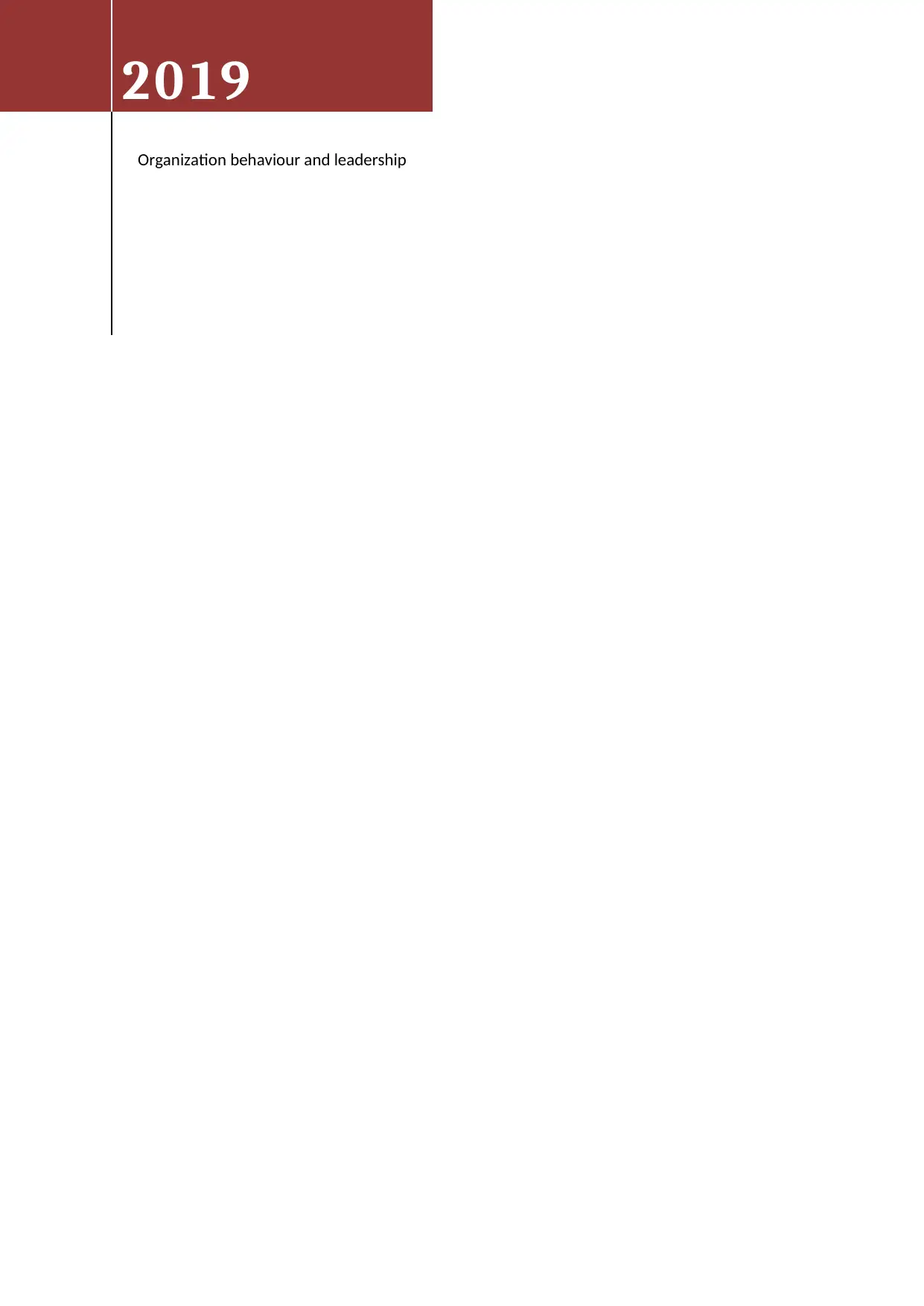
2019
Organization behaviour and leadership
Organization behaviour and leadership
Paraphrase This Document
Need a fresh take? Get an instant paraphrase of this document with our AI Paraphraser
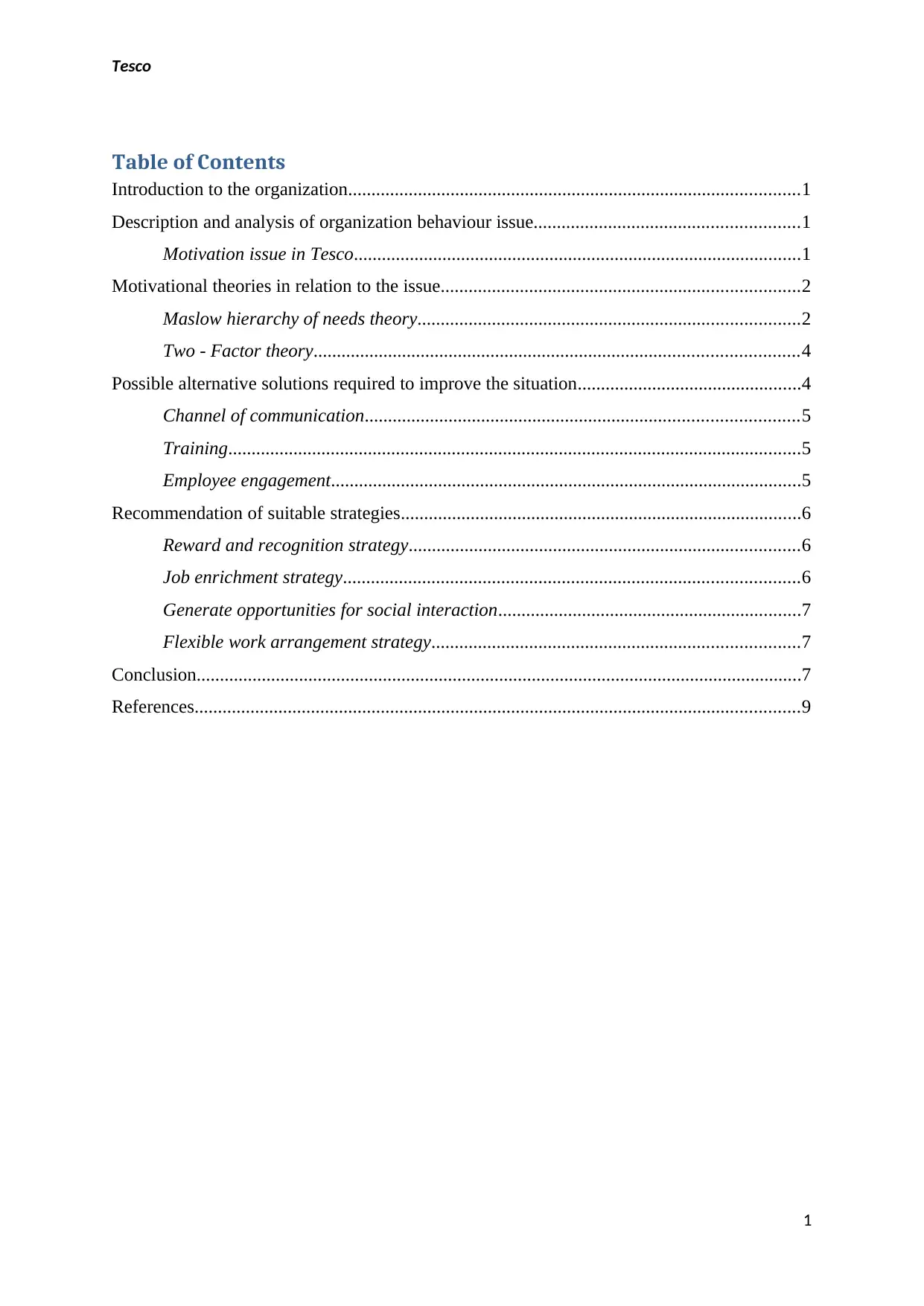
Tesco
Table of Contents
Introduction to the organization.................................................................................................1
Description and analysis of organization behaviour issue.........................................................1
Motivation issue in Tesco................................................................................................1
Motivational theories in relation to the issue.............................................................................2
Maslow hierarchy of needs theory..................................................................................2
Two - Factor theory........................................................................................................4
Possible alternative solutions required to improve the situation................................................4
Channel of communication.............................................................................................5
Training...........................................................................................................................5
Employee engagement.....................................................................................................5
Recommendation of suitable strategies......................................................................................6
Reward and recognition strategy....................................................................................6
Job enrichment strategy..................................................................................................6
Generate opportunities for social interaction.................................................................7
Flexible work arrangement strategy...............................................................................7
Conclusion..................................................................................................................................7
References..................................................................................................................................9
1
Table of Contents
Introduction to the organization.................................................................................................1
Description and analysis of organization behaviour issue.........................................................1
Motivation issue in Tesco................................................................................................1
Motivational theories in relation to the issue.............................................................................2
Maslow hierarchy of needs theory..................................................................................2
Two - Factor theory........................................................................................................4
Possible alternative solutions required to improve the situation................................................4
Channel of communication.............................................................................................5
Training...........................................................................................................................5
Employee engagement.....................................................................................................5
Recommendation of suitable strategies......................................................................................6
Reward and recognition strategy....................................................................................6
Job enrichment strategy..................................................................................................6
Generate opportunities for social interaction.................................................................7
Flexible work arrangement strategy...............................................................................7
Conclusion..................................................................................................................................7
References..................................................................................................................................9
1
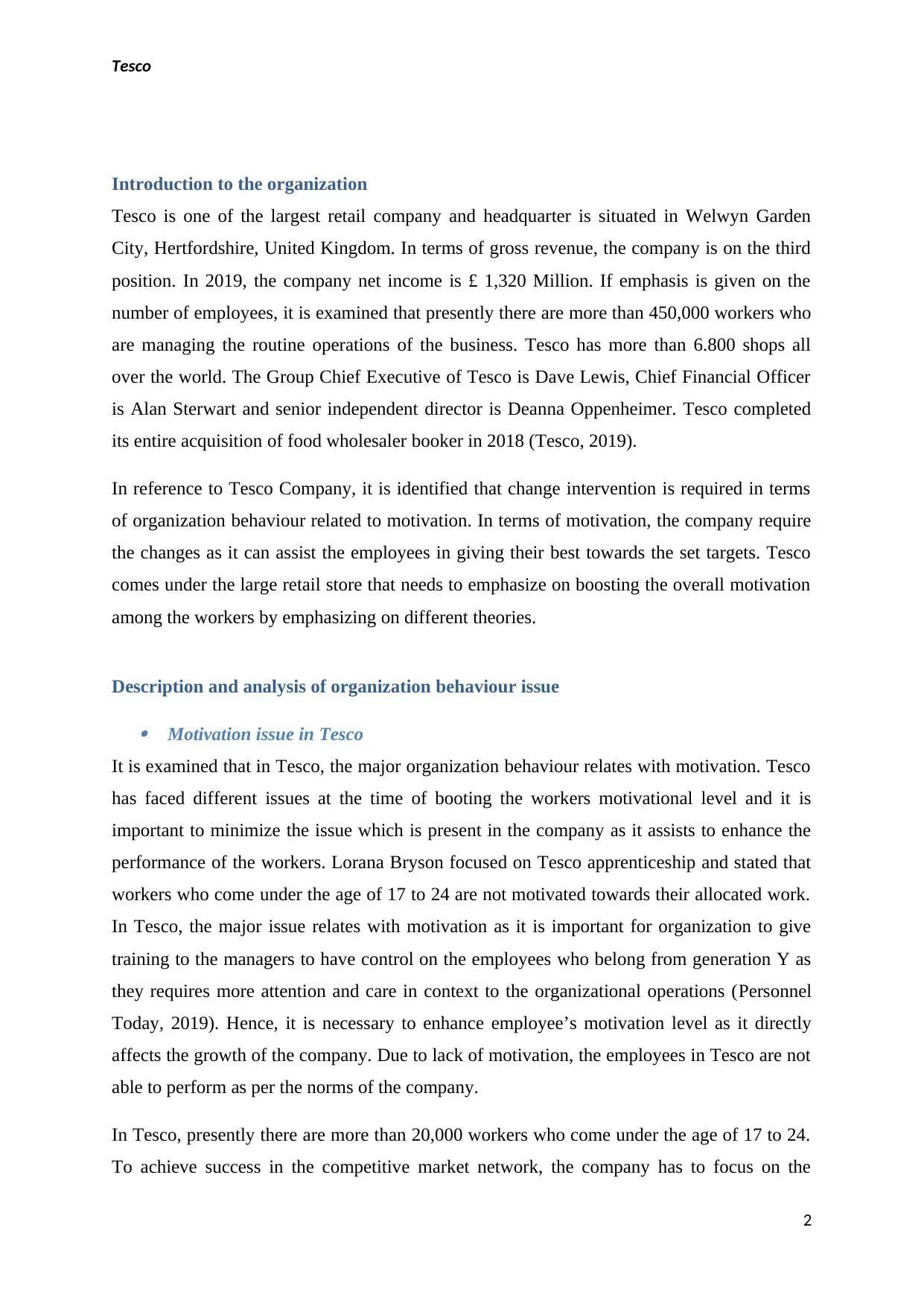
Tesco
Introduction to the organization
Tesco is one of the largest retail company and headquarter is situated in Welwyn Garden
City, Hertfordshire, United Kingdom. In terms of gross revenue, the company is on the third
position. In 2019, the company net income is £ 1,320 Million. If emphasis is given on the
number of employees, it is examined that presently there are more than 450,000 workers who
are managing the routine operations of the business. Tesco has more than 6.800 shops all
over the world. The Group Chief Executive of Tesco is Dave Lewis, Chief Financial Officer
is Alan Sterwart and senior independent director is Deanna Oppenheimer. Tesco completed
its entire acquisition of food wholesaler booker in 2018 (Tesco, 2019).
In reference to Tesco Company, it is identified that change intervention is required in terms
of organization behaviour related to motivation. In terms of motivation, the company require
the changes as it can assist the employees in giving their best towards the set targets. Tesco
comes under the large retail store that needs to emphasize on boosting the overall motivation
among the workers by emphasizing on different theories.
Description and analysis of organization behaviour issue
Motivation issue in Tesco
It is examined that in Tesco, the major organization behaviour relates with motivation. Tesco
has faced different issues at the time of booting the workers motivational level and it is
important to minimize the issue which is present in the company as it assists to enhance the
performance of the workers. Lorana Bryson focused on Tesco apprenticeship and stated that
workers who come under the age of 17 to 24 are not motivated towards their allocated work.
In Tesco, the major issue relates with motivation as it is important for organization to give
training to the managers to have control on the employees who belong from generation Y as
they requires more attention and care in context to the organizational operations (Personnel
Today, 2019). Hence, it is necessary to enhance employee’s motivation level as it directly
affects the growth of the company. Due to lack of motivation, the employees in Tesco are not
able to perform as per the norms of the company.
In Tesco, presently there are more than 20,000 workers who come under the age of 17 to 24.
To achieve success in the competitive market network, the company has to focus on the
2
Introduction to the organization
Tesco is one of the largest retail company and headquarter is situated in Welwyn Garden
City, Hertfordshire, United Kingdom. In terms of gross revenue, the company is on the third
position. In 2019, the company net income is £ 1,320 Million. If emphasis is given on the
number of employees, it is examined that presently there are more than 450,000 workers who
are managing the routine operations of the business. Tesco has more than 6.800 shops all
over the world. The Group Chief Executive of Tesco is Dave Lewis, Chief Financial Officer
is Alan Sterwart and senior independent director is Deanna Oppenheimer. Tesco completed
its entire acquisition of food wholesaler booker in 2018 (Tesco, 2019).
In reference to Tesco Company, it is identified that change intervention is required in terms
of organization behaviour related to motivation. In terms of motivation, the company require
the changes as it can assist the employees in giving their best towards the set targets. Tesco
comes under the large retail store that needs to emphasize on boosting the overall motivation
among the workers by emphasizing on different theories.
Description and analysis of organization behaviour issue
Motivation issue in Tesco
It is examined that in Tesco, the major organization behaviour relates with motivation. Tesco
has faced different issues at the time of booting the workers motivational level and it is
important to minimize the issue which is present in the company as it assists to enhance the
performance of the workers. Lorana Bryson focused on Tesco apprenticeship and stated that
workers who come under the age of 17 to 24 are not motivated towards their allocated work.
In Tesco, the major issue relates with motivation as it is important for organization to give
training to the managers to have control on the employees who belong from generation Y as
they requires more attention and care in context to the organizational operations (Personnel
Today, 2019). Hence, it is necessary to enhance employee’s motivation level as it directly
affects the growth of the company. Due to lack of motivation, the employees in Tesco are not
able to perform as per the norms of the company.
In Tesco, presently there are more than 20,000 workers who come under the age of 17 to 24.
To achieve success in the competitive market network, the company has to focus on the
2
⊘ This is a preview!⊘
Do you want full access?
Subscribe today to unlock all pages.

Trusted by 1+ million students worldwide
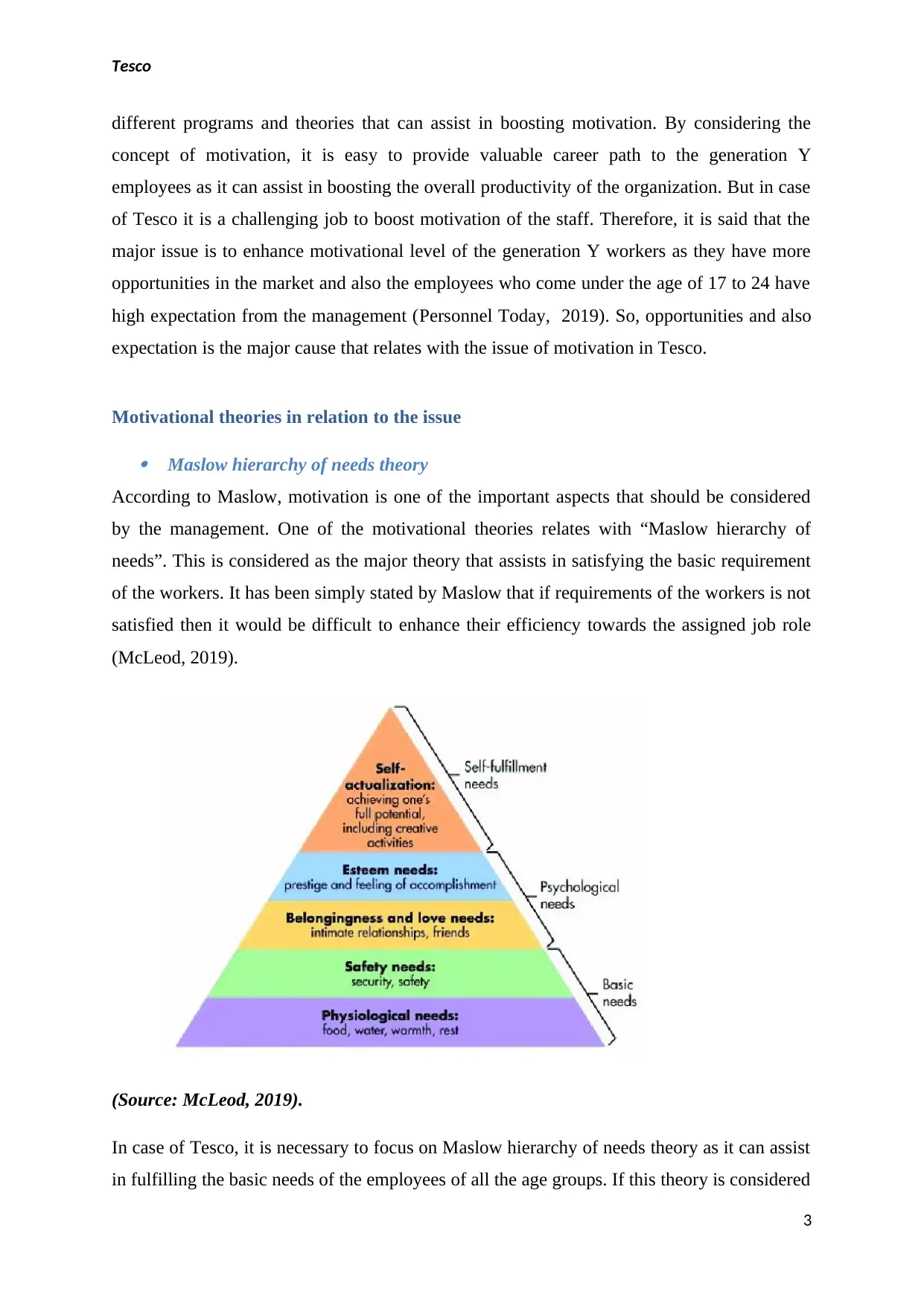
Tesco
different programs and theories that can assist in boosting motivation. By considering the
concept of motivation, it is easy to provide valuable career path to the generation Y
employees as it can assist in boosting the overall productivity of the organization. But in case
of Tesco it is a challenging job to boost motivation of the staff. Therefore, it is said that the
major issue is to enhance motivational level of the generation Y workers as they have more
opportunities in the market and also the employees who come under the age of 17 to 24 have
high expectation from the management (Personnel Today, 2019). So, opportunities and also
expectation is the major cause that relates with the issue of motivation in Tesco.
Motivational theories in relation to the issue
Maslow hierarchy of needs theory
According to Maslow, motivation is one of the important aspects that should be considered
by the management. One of the motivational theories relates with “Maslow hierarchy of
needs”. This is considered as the major theory that assists in satisfying the basic requirement
of the workers. It has been simply stated by Maslow that if requirements of the workers is not
satisfied then it would be difficult to enhance their efficiency towards the assigned job role
(McLeod, 2019).
(Source: McLeod, 2019).
In case of Tesco, it is necessary to focus on Maslow hierarchy of needs theory as it can assist
in fulfilling the basic needs of the employees of all the age groups. If this theory is considered
3
different programs and theories that can assist in boosting motivation. By considering the
concept of motivation, it is easy to provide valuable career path to the generation Y
employees as it can assist in boosting the overall productivity of the organization. But in case
of Tesco it is a challenging job to boost motivation of the staff. Therefore, it is said that the
major issue is to enhance motivational level of the generation Y workers as they have more
opportunities in the market and also the employees who come under the age of 17 to 24 have
high expectation from the management (Personnel Today, 2019). So, opportunities and also
expectation is the major cause that relates with the issue of motivation in Tesco.
Motivational theories in relation to the issue
Maslow hierarchy of needs theory
According to Maslow, motivation is one of the important aspects that should be considered
by the management. One of the motivational theories relates with “Maslow hierarchy of
needs”. This is considered as the major theory that assists in satisfying the basic requirement
of the workers. It has been simply stated by Maslow that if requirements of the workers is not
satisfied then it would be difficult to enhance their efficiency towards the assigned job role
(McLeod, 2019).
(Source: McLeod, 2019).
In case of Tesco, it is necessary to focus on Maslow hierarchy of needs theory as it can assist
in fulfilling the basic needs of the employees of all the age groups. If this theory is considered
3
Paraphrase This Document
Need a fresh take? Get an instant paraphrase of this document with our AI Paraphraser
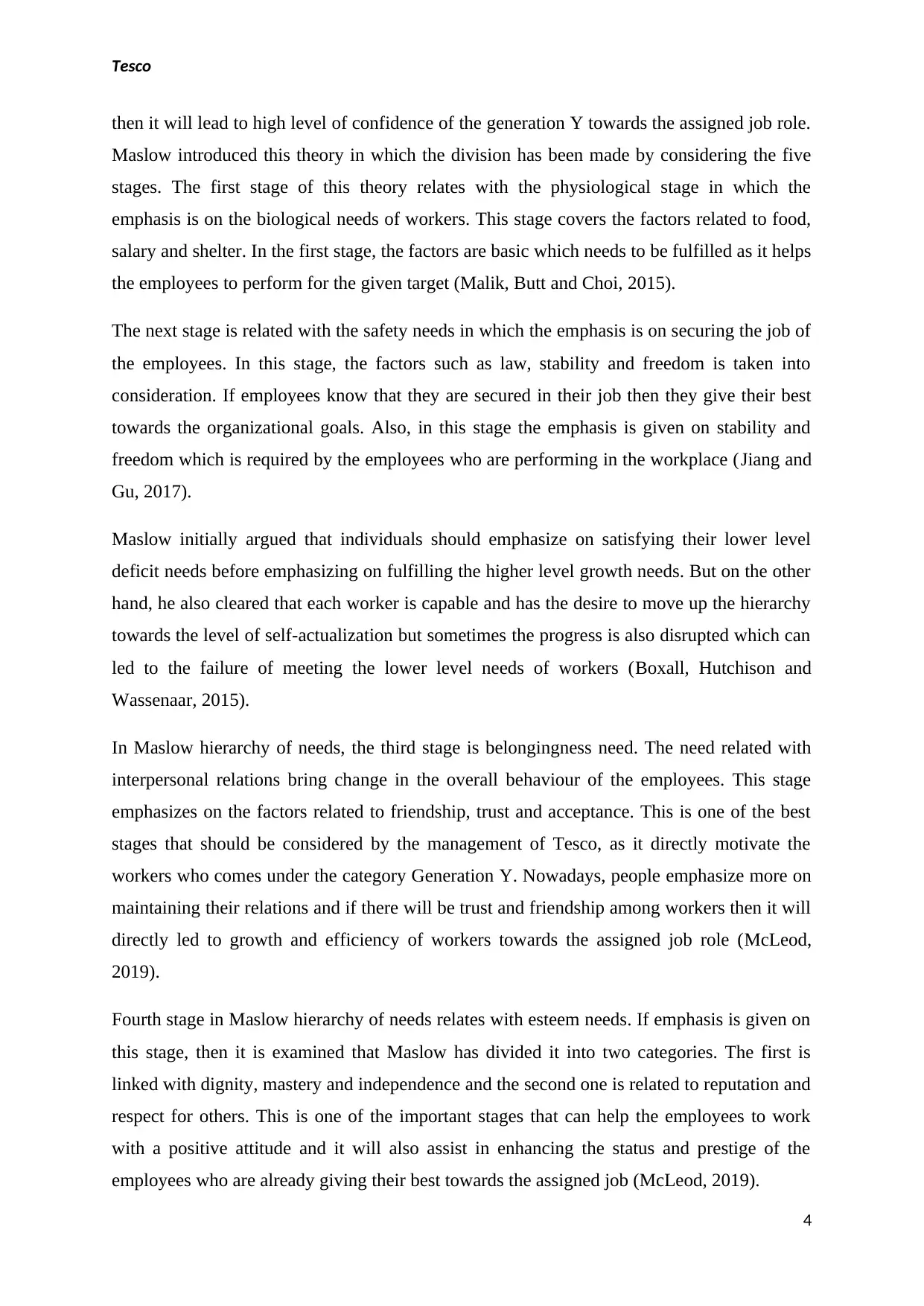
Tesco
then it will lead to high level of confidence of the generation Y towards the assigned job role.
Maslow introduced this theory in which the division has been made by considering the five
stages. The first stage of this theory relates with the physiological stage in which the
emphasis is on the biological needs of workers. This stage covers the factors related to food,
salary and shelter. In the first stage, the factors are basic which needs to be fulfilled as it helps
the employees to perform for the given target (Malik, Butt and Choi, 2015).
The next stage is related with the safety needs in which the emphasis is on securing the job of
the employees. In this stage, the factors such as law, stability and freedom is taken into
consideration. If employees know that they are secured in their job then they give their best
towards the organizational goals. Also, in this stage the emphasis is given on stability and
freedom which is required by the employees who are performing in the workplace (Jiang and
Gu, 2017).
Maslow initially argued that individuals should emphasize on satisfying their lower level
deficit needs before emphasizing on fulfilling the higher level growth needs. But on the other
hand, he also cleared that each worker is capable and has the desire to move up the hierarchy
towards the level of self-actualization but sometimes the progress is also disrupted which can
led to the failure of meeting the lower level needs of workers (Boxall, Hutchison and
Wassenaar, 2015).
In Maslow hierarchy of needs, the third stage is belongingness need. The need related with
interpersonal relations bring change in the overall behaviour of the employees. This stage
emphasizes on the factors related to friendship, trust and acceptance. This is one of the best
stages that should be considered by the management of Tesco, as it directly motivate the
workers who comes under the category Generation Y. Nowadays, people emphasize more on
maintaining their relations and if there will be trust and friendship among workers then it will
directly led to growth and efficiency of workers towards the assigned job role (McLeod,
2019).
Fourth stage in Maslow hierarchy of needs relates with esteem needs. If emphasis is given on
this stage, then it is examined that Maslow has divided it into two categories. The first is
linked with dignity, mastery and independence and the second one is related to reputation and
respect for others. This is one of the important stages that can help the employees to work
with a positive attitude and it will also assist in enhancing the status and prestige of the
employees who are already giving their best towards the assigned job (McLeod, 2019).
4
then it will lead to high level of confidence of the generation Y towards the assigned job role.
Maslow introduced this theory in which the division has been made by considering the five
stages. The first stage of this theory relates with the physiological stage in which the
emphasis is on the biological needs of workers. This stage covers the factors related to food,
salary and shelter. In the first stage, the factors are basic which needs to be fulfilled as it helps
the employees to perform for the given target (Malik, Butt and Choi, 2015).
The next stage is related with the safety needs in which the emphasis is on securing the job of
the employees. In this stage, the factors such as law, stability and freedom is taken into
consideration. If employees know that they are secured in their job then they give their best
towards the organizational goals. Also, in this stage the emphasis is given on stability and
freedom which is required by the employees who are performing in the workplace (Jiang and
Gu, 2017).
Maslow initially argued that individuals should emphasize on satisfying their lower level
deficit needs before emphasizing on fulfilling the higher level growth needs. But on the other
hand, he also cleared that each worker is capable and has the desire to move up the hierarchy
towards the level of self-actualization but sometimes the progress is also disrupted which can
led to the failure of meeting the lower level needs of workers (Boxall, Hutchison and
Wassenaar, 2015).
In Maslow hierarchy of needs, the third stage is belongingness need. The need related with
interpersonal relations bring change in the overall behaviour of the employees. This stage
emphasizes on the factors related to friendship, trust and acceptance. This is one of the best
stages that should be considered by the management of Tesco, as it directly motivate the
workers who comes under the category Generation Y. Nowadays, people emphasize more on
maintaining their relations and if there will be trust and friendship among workers then it will
directly led to growth and efficiency of workers towards the assigned job role (McLeod,
2019).
Fourth stage in Maslow hierarchy of needs relates with esteem needs. If emphasis is given on
this stage, then it is examined that Maslow has divided it into two categories. The first is
linked with dignity, mastery and independence and the second one is related to reputation and
respect for others. This is one of the important stages that can help the employees to work
with a positive attitude and it will also assist in enhancing the status and prestige of the
employees who are already giving their best towards the assigned job (McLeod, 2019).
4
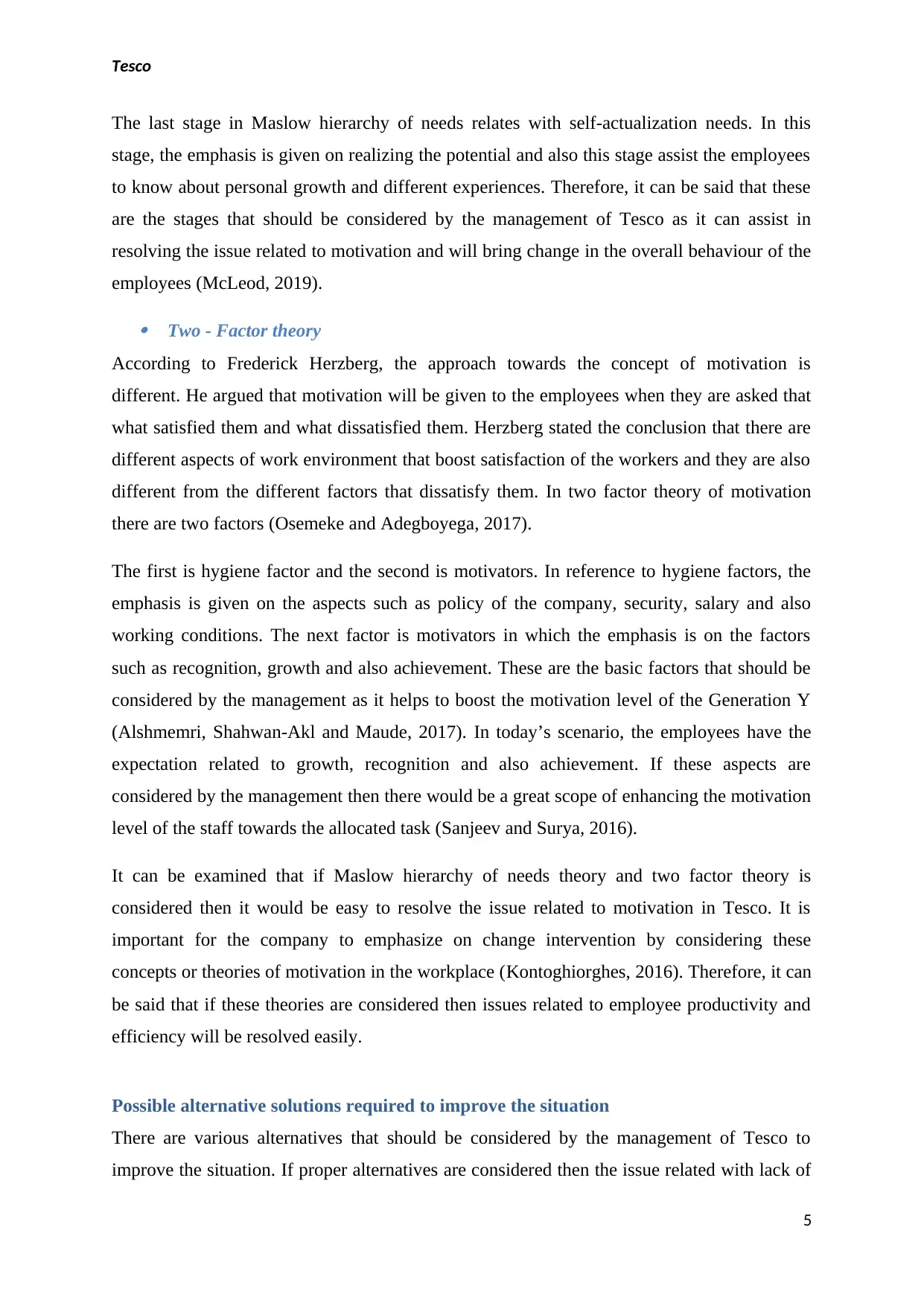
Tesco
The last stage in Maslow hierarchy of needs relates with self-actualization needs. In this
stage, the emphasis is given on realizing the potential and also this stage assist the employees
to know about personal growth and different experiences. Therefore, it can be said that these
are the stages that should be considered by the management of Tesco as it can assist in
resolving the issue related to motivation and will bring change in the overall behaviour of the
employees (McLeod, 2019).
Two - Factor theory
According to Frederick Herzberg, the approach towards the concept of motivation is
different. He argued that motivation will be given to the employees when they are asked that
what satisfied them and what dissatisfied them. Herzberg stated the conclusion that there are
different aspects of work environment that boost satisfaction of the workers and they are also
different from the different factors that dissatisfy them. In two factor theory of motivation
there are two factors (Osemeke and Adegboyega, 2017).
The first is hygiene factor and the second is motivators. In reference to hygiene factors, the
emphasis is given on the aspects such as policy of the company, security, salary and also
working conditions. The next factor is motivators in which the emphasis is on the factors
such as recognition, growth and also achievement. These are the basic factors that should be
considered by the management as it helps to boost the motivation level of the Generation Y
(Alshmemri, Shahwan-Akl and Maude, 2017). In today’s scenario, the employees have the
expectation related to growth, recognition and also achievement. If these aspects are
considered by the management then there would be a great scope of enhancing the motivation
level of the staff towards the allocated task (Sanjeev and Surya, 2016).
It can be examined that if Maslow hierarchy of needs theory and two factor theory is
considered then it would be easy to resolve the issue related to motivation in Tesco. It is
important for the company to emphasize on change intervention by considering these
concepts or theories of motivation in the workplace (Kontoghiorghes, 2016). Therefore, it can
be said that if these theories are considered then issues related to employee productivity and
efficiency will be resolved easily.
Possible alternative solutions required to improve the situation
There are various alternatives that should be considered by the management of Tesco to
improve the situation. If proper alternatives are considered then the issue related with lack of
5
The last stage in Maslow hierarchy of needs relates with self-actualization needs. In this
stage, the emphasis is given on realizing the potential and also this stage assist the employees
to know about personal growth and different experiences. Therefore, it can be said that these
are the stages that should be considered by the management of Tesco as it can assist in
resolving the issue related to motivation and will bring change in the overall behaviour of the
employees (McLeod, 2019).
Two - Factor theory
According to Frederick Herzberg, the approach towards the concept of motivation is
different. He argued that motivation will be given to the employees when they are asked that
what satisfied them and what dissatisfied them. Herzberg stated the conclusion that there are
different aspects of work environment that boost satisfaction of the workers and they are also
different from the different factors that dissatisfy them. In two factor theory of motivation
there are two factors (Osemeke and Adegboyega, 2017).
The first is hygiene factor and the second is motivators. In reference to hygiene factors, the
emphasis is given on the aspects such as policy of the company, security, salary and also
working conditions. The next factor is motivators in which the emphasis is on the factors
such as recognition, growth and also achievement. These are the basic factors that should be
considered by the management as it helps to boost the motivation level of the Generation Y
(Alshmemri, Shahwan-Akl and Maude, 2017). In today’s scenario, the employees have the
expectation related to growth, recognition and also achievement. If these aspects are
considered by the management then there would be a great scope of enhancing the motivation
level of the staff towards the allocated task (Sanjeev and Surya, 2016).
It can be examined that if Maslow hierarchy of needs theory and two factor theory is
considered then it would be easy to resolve the issue related to motivation in Tesco. It is
important for the company to emphasize on change intervention by considering these
concepts or theories of motivation in the workplace (Kontoghiorghes, 2016). Therefore, it can
be said that if these theories are considered then issues related to employee productivity and
efficiency will be resolved easily.
Possible alternative solutions required to improve the situation
There are various alternatives that should be considered by the management of Tesco to
improve the situation. If proper alternatives are considered then the issue related with lack of
5
⊘ This is a preview!⊘
Do you want full access?
Subscribe today to unlock all pages.

Trusted by 1+ million students worldwide
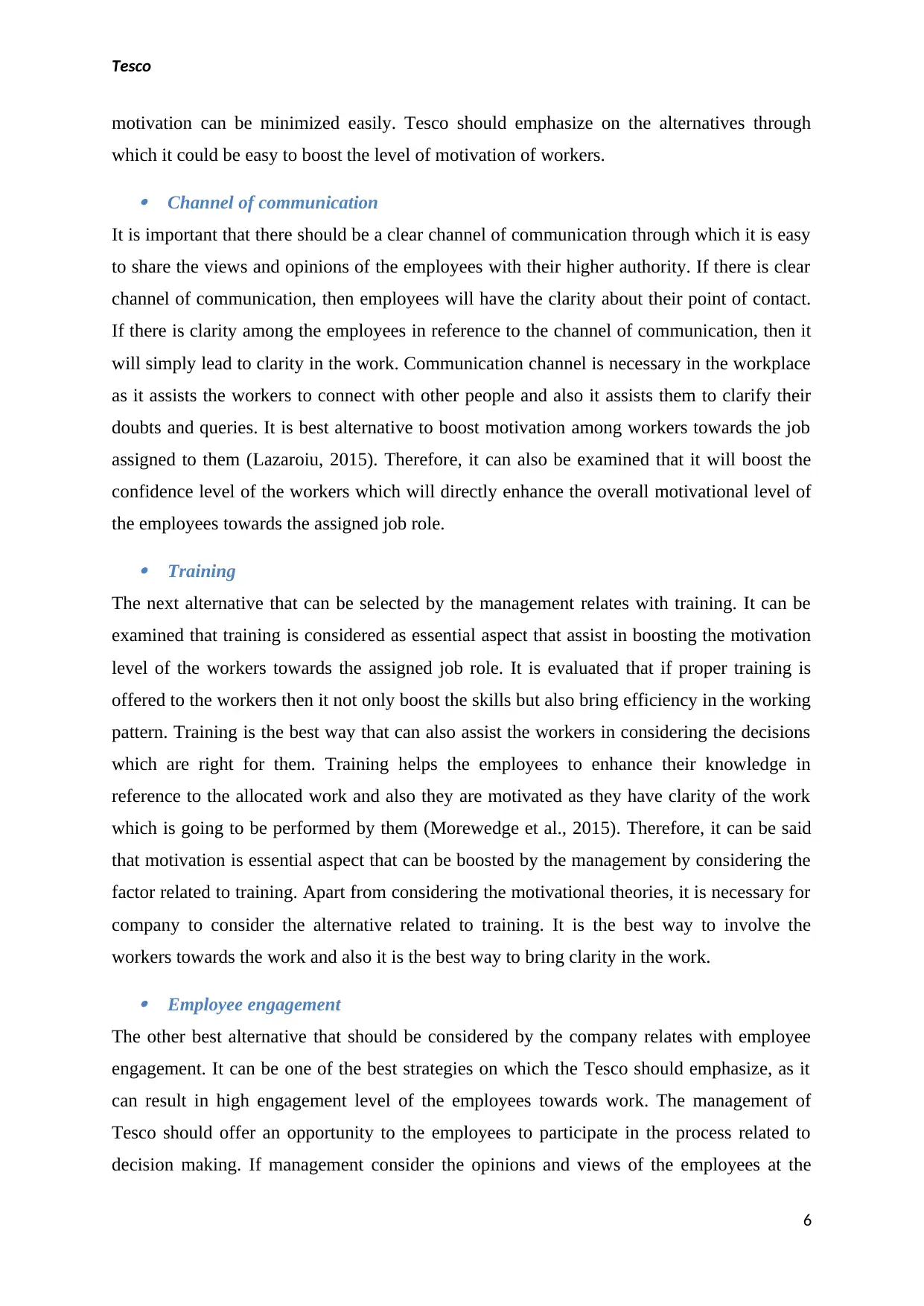
Tesco
motivation can be minimized easily. Tesco should emphasize on the alternatives through
which it could be easy to boost the level of motivation of workers.
Channel of communication
It is important that there should be a clear channel of communication through which it is easy
to share the views and opinions of the employees with their higher authority. If there is clear
channel of communication, then employees will have the clarity about their point of contact.
If there is clarity among the employees in reference to the channel of communication, then it
will simply lead to clarity in the work. Communication channel is necessary in the workplace
as it assists the workers to connect with other people and also it assists them to clarify their
doubts and queries. It is best alternative to boost motivation among workers towards the job
assigned to them (Lazaroiu, 2015). Therefore, it can also be examined that it will boost the
confidence level of the workers which will directly enhance the overall motivational level of
the employees towards the assigned job role.
Training
The next alternative that can be selected by the management relates with training. It can be
examined that training is considered as essential aspect that assist in boosting the motivation
level of the workers towards the assigned job role. It is evaluated that if proper training is
offered to the workers then it not only boost the skills but also bring efficiency in the working
pattern. Training is the best way that can also assist the workers in considering the decisions
which are right for them. Training helps the employees to enhance their knowledge in
reference to the allocated work and also they are motivated as they have clarity of the work
which is going to be performed by them (Morewedge et al., 2015). Therefore, it can be said
that motivation is essential aspect that can be boosted by the management by considering the
factor related to training. Apart from considering the motivational theories, it is necessary for
company to consider the alternative related to training. It is the best way to involve the
workers towards the work and also it is the best way to bring clarity in the work.
Employee engagement
The other best alternative that should be considered by the company relates with employee
engagement. It can be one of the best strategies on which the Tesco should emphasize, as it
can result in high engagement level of the employees towards work. The management of
Tesco should offer an opportunity to the employees to participate in the process related to
decision making. If management consider the opinions and views of the employees at the
6
motivation can be minimized easily. Tesco should emphasize on the alternatives through
which it could be easy to boost the level of motivation of workers.
Channel of communication
It is important that there should be a clear channel of communication through which it is easy
to share the views and opinions of the employees with their higher authority. If there is clear
channel of communication, then employees will have the clarity about their point of contact.
If there is clarity among the employees in reference to the channel of communication, then it
will simply lead to clarity in the work. Communication channel is necessary in the workplace
as it assists the workers to connect with other people and also it assists them to clarify their
doubts and queries. It is best alternative to boost motivation among workers towards the job
assigned to them (Lazaroiu, 2015). Therefore, it can also be examined that it will boost the
confidence level of the workers which will directly enhance the overall motivational level of
the employees towards the assigned job role.
Training
The next alternative that can be selected by the management relates with training. It can be
examined that training is considered as essential aspect that assist in boosting the motivation
level of the workers towards the assigned job role. It is evaluated that if proper training is
offered to the workers then it not only boost the skills but also bring efficiency in the working
pattern. Training is the best way that can also assist the workers in considering the decisions
which are right for them. Training helps the employees to enhance their knowledge in
reference to the allocated work and also they are motivated as they have clarity of the work
which is going to be performed by them (Morewedge et al., 2015). Therefore, it can be said
that motivation is essential aspect that can be boosted by the management by considering the
factor related to training. Apart from considering the motivational theories, it is necessary for
company to consider the alternative related to training. It is the best way to involve the
workers towards the work and also it is the best way to bring clarity in the work.
Employee engagement
The other best alternative that should be considered by the company relates with employee
engagement. It can be one of the best strategies on which the Tesco should emphasize, as it
can result in high engagement level of the employees towards work. The management of
Tesco should offer an opportunity to the employees to participate in the process related to
decision making. If management consider the opinions and views of the employees at the
6
Paraphrase This Document
Need a fresh take? Get an instant paraphrase of this document with our AI Paraphraser
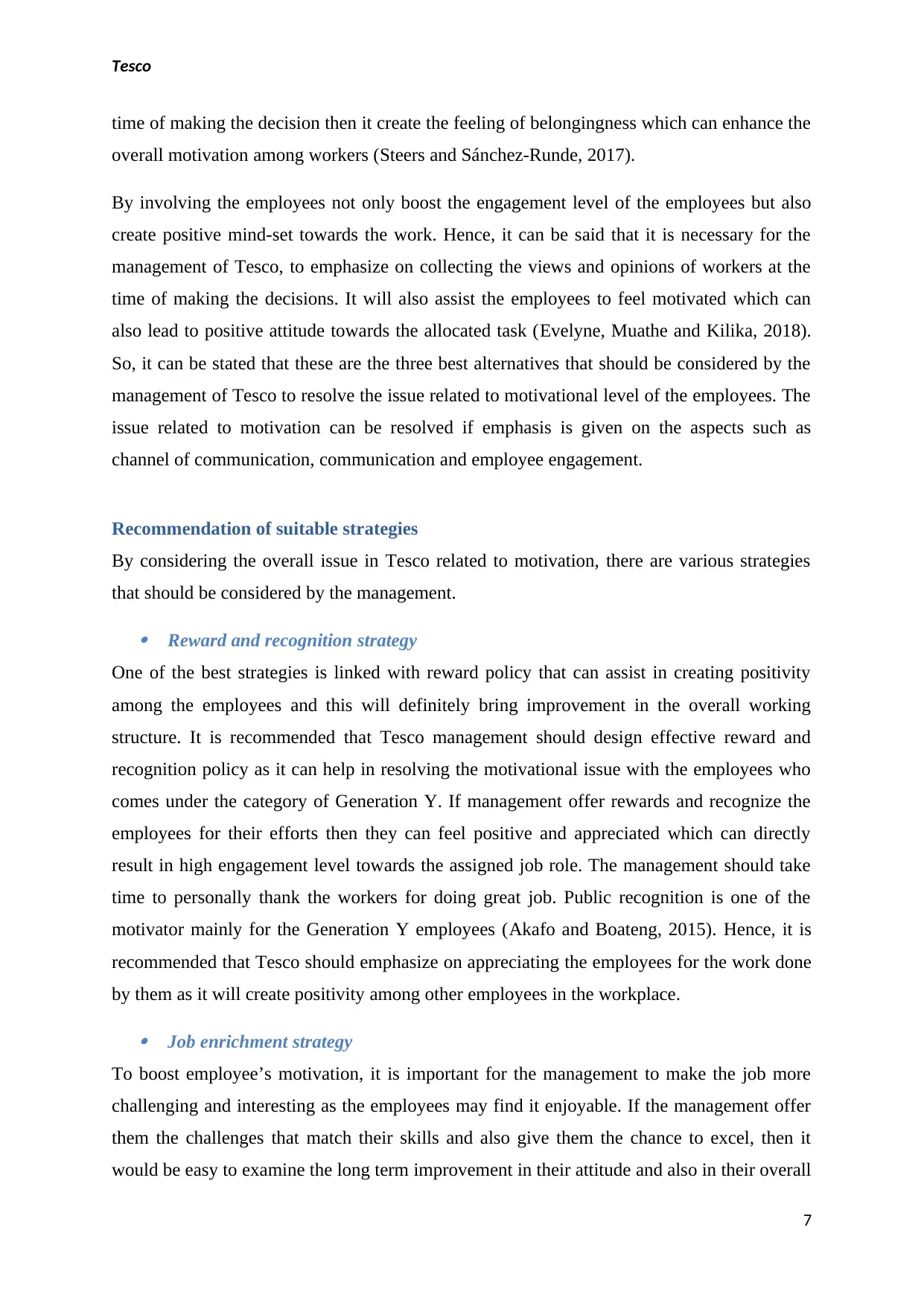
Tesco
time of making the decision then it create the feeling of belongingness which can enhance the
overall motivation among workers (Steers and Sánchez‐Runde, 2017).
By involving the employees not only boost the engagement level of the employees but also
create positive mind-set towards the work. Hence, it can be said that it is necessary for the
management of Tesco, to emphasize on collecting the views and opinions of workers at the
time of making the decisions. It will also assist the employees to feel motivated which can
also lead to positive attitude towards the allocated task (Evelyne, Muathe and Kilika, 2018).
So, it can be stated that these are the three best alternatives that should be considered by the
management of Tesco to resolve the issue related to motivational level of the employees. The
issue related to motivation can be resolved if emphasis is given on the aspects such as
channel of communication, communication and employee engagement.
Recommendation of suitable strategies
By considering the overall issue in Tesco related to motivation, there are various strategies
that should be considered by the management.
Reward and recognition strategy
One of the best strategies is linked with reward policy that can assist in creating positivity
among the employees and this will definitely bring improvement in the overall working
structure. It is recommended that Tesco management should design effective reward and
recognition policy as it can help in resolving the motivational issue with the employees who
comes under the category of Generation Y. If management offer rewards and recognize the
employees for their efforts then they can feel positive and appreciated which can directly
result in high engagement level towards the assigned job role. The management should take
time to personally thank the workers for doing great job. Public recognition is one of the
motivator mainly for the Generation Y employees (Akafo and Boateng, 2015). Hence, it is
recommended that Tesco should emphasize on appreciating the employees for the work done
by them as it will create positivity among other employees in the workplace.
Job enrichment strategy
To boost employee’s motivation, it is important for the management to make the job more
challenging and interesting as the employees may find it enjoyable. If the management offer
them the challenges that match their skills and also give them the chance to excel, then it
would be easy to examine the long term improvement in their attitude and also in their overall
7
time of making the decision then it create the feeling of belongingness which can enhance the
overall motivation among workers (Steers and Sánchez‐Runde, 2017).
By involving the employees not only boost the engagement level of the employees but also
create positive mind-set towards the work. Hence, it can be said that it is necessary for the
management of Tesco, to emphasize on collecting the views and opinions of workers at the
time of making the decisions. It will also assist the employees to feel motivated which can
also lead to positive attitude towards the allocated task (Evelyne, Muathe and Kilika, 2018).
So, it can be stated that these are the three best alternatives that should be considered by the
management of Tesco to resolve the issue related to motivational level of the employees. The
issue related to motivation can be resolved if emphasis is given on the aspects such as
channel of communication, communication and employee engagement.
Recommendation of suitable strategies
By considering the overall issue in Tesco related to motivation, there are various strategies
that should be considered by the management.
Reward and recognition strategy
One of the best strategies is linked with reward policy that can assist in creating positivity
among the employees and this will definitely bring improvement in the overall working
structure. It is recommended that Tesco management should design effective reward and
recognition policy as it can help in resolving the motivational issue with the employees who
comes under the category of Generation Y. If management offer rewards and recognize the
employees for their efforts then they can feel positive and appreciated which can directly
result in high engagement level towards the assigned job role. The management should take
time to personally thank the workers for doing great job. Public recognition is one of the
motivator mainly for the Generation Y employees (Akafo and Boateng, 2015). Hence, it is
recommended that Tesco should emphasize on appreciating the employees for the work done
by them as it will create positivity among other employees in the workplace.
Job enrichment strategy
To boost employee’s motivation, it is important for the management to make the job more
challenging and interesting as the employees may find it enjoyable. If the management offer
them the challenges that match their skills and also give them the chance to excel, then it
would be easy to examine the long term improvement in their attitude and also in their overall
7
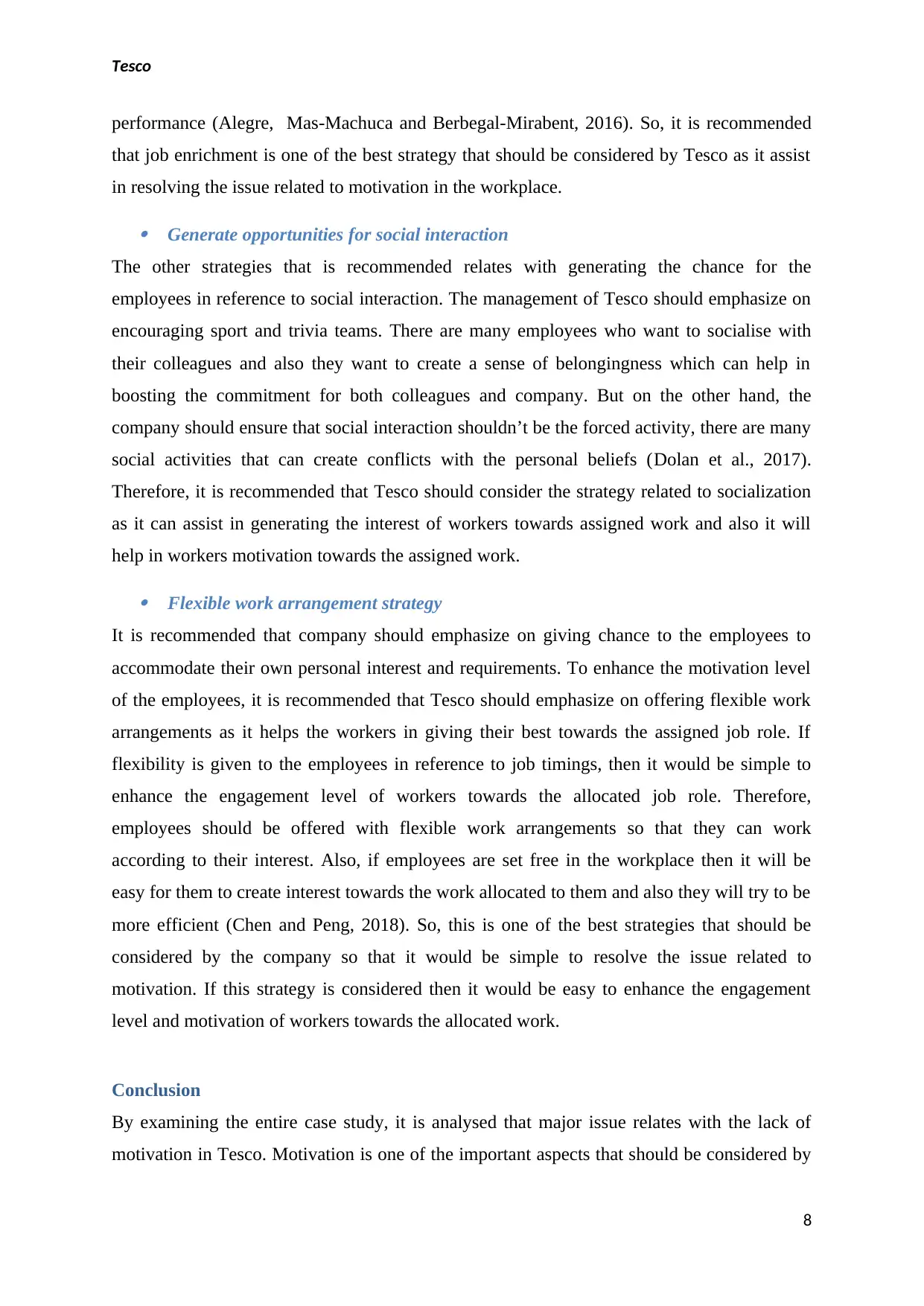
Tesco
performance (Alegre, Mas-Machuca and Berbegal-Mirabent, 2016). So, it is recommended
that job enrichment is one of the best strategy that should be considered by Tesco as it assist
in resolving the issue related to motivation in the workplace.
Generate opportunities for social interaction
The other strategies that is recommended relates with generating the chance for the
employees in reference to social interaction. The management of Tesco should emphasize on
encouraging sport and trivia teams. There are many employees who want to socialise with
their colleagues and also they want to create a sense of belongingness which can help in
boosting the commitment for both colleagues and company. But on the other hand, the
company should ensure that social interaction shouldn’t be the forced activity, there are many
social activities that can create conflicts with the personal beliefs (Dolan et al., 2017).
Therefore, it is recommended that Tesco should consider the strategy related to socialization
as it can assist in generating the interest of workers towards assigned work and also it will
help in workers motivation towards the assigned work.
Flexible work arrangement strategy
It is recommended that company should emphasize on giving chance to the employees to
accommodate their own personal interest and requirements. To enhance the motivation level
of the employees, it is recommended that Tesco should emphasize on offering flexible work
arrangements as it helps the workers in giving their best towards the assigned job role. If
flexibility is given to the employees in reference to job timings, then it would be simple to
enhance the engagement level of workers towards the allocated job role. Therefore,
employees should be offered with flexible work arrangements so that they can work
according to their interest. Also, if employees are set free in the workplace then it will be
easy for them to create interest towards the work allocated to them and also they will try to be
more efficient (Chen and Peng, 2018). So, this is one of the best strategies that should be
considered by the company so that it would be simple to resolve the issue related to
motivation. If this strategy is considered then it would be easy to enhance the engagement
level and motivation of workers towards the allocated work.
Conclusion
By examining the entire case study, it is analysed that major issue relates with the lack of
motivation in Tesco. Motivation is one of the important aspects that should be considered by
8
performance (Alegre, Mas-Machuca and Berbegal-Mirabent, 2016). So, it is recommended
that job enrichment is one of the best strategy that should be considered by Tesco as it assist
in resolving the issue related to motivation in the workplace.
Generate opportunities for social interaction
The other strategies that is recommended relates with generating the chance for the
employees in reference to social interaction. The management of Tesco should emphasize on
encouraging sport and trivia teams. There are many employees who want to socialise with
their colleagues and also they want to create a sense of belongingness which can help in
boosting the commitment for both colleagues and company. But on the other hand, the
company should ensure that social interaction shouldn’t be the forced activity, there are many
social activities that can create conflicts with the personal beliefs (Dolan et al., 2017).
Therefore, it is recommended that Tesco should consider the strategy related to socialization
as it can assist in generating the interest of workers towards assigned work and also it will
help in workers motivation towards the assigned work.
Flexible work arrangement strategy
It is recommended that company should emphasize on giving chance to the employees to
accommodate their own personal interest and requirements. To enhance the motivation level
of the employees, it is recommended that Tesco should emphasize on offering flexible work
arrangements as it helps the workers in giving their best towards the assigned job role. If
flexibility is given to the employees in reference to job timings, then it would be simple to
enhance the engagement level of workers towards the allocated job role. Therefore,
employees should be offered with flexible work arrangements so that they can work
according to their interest. Also, if employees are set free in the workplace then it will be
easy for them to create interest towards the work allocated to them and also they will try to be
more efficient (Chen and Peng, 2018). So, this is one of the best strategies that should be
considered by the company so that it would be simple to resolve the issue related to
motivation. If this strategy is considered then it would be easy to enhance the engagement
level and motivation of workers towards the allocated work.
Conclusion
By examining the entire case study, it is analysed that major issue relates with the lack of
motivation in Tesco. Motivation is one of the important aspects that should be considered by
8
⊘ This is a preview!⊘
Do you want full access?
Subscribe today to unlock all pages.

Trusted by 1+ million students worldwide
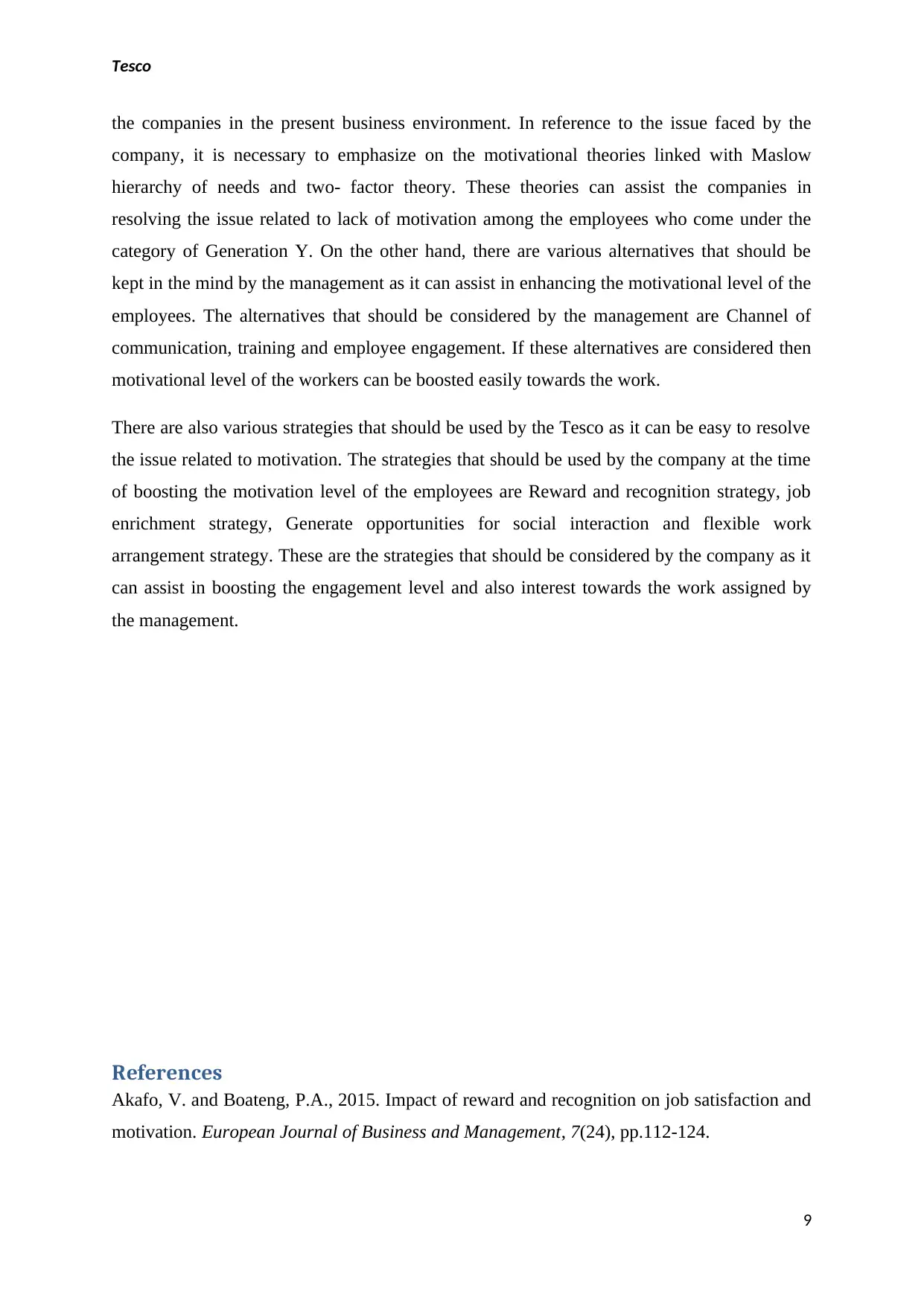
Tesco
the companies in the present business environment. In reference to the issue faced by the
company, it is necessary to emphasize on the motivational theories linked with Maslow
hierarchy of needs and two- factor theory. These theories can assist the companies in
resolving the issue related to lack of motivation among the employees who come under the
category of Generation Y. On the other hand, there are various alternatives that should be
kept in the mind by the management as it can assist in enhancing the motivational level of the
employees. The alternatives that should be considered by the management are Channel of
communication, training and employee engagement. If these alternatives are considered then
motivational level of the workers can be boosted easily towards the work.
There are also various strategies that should be used by the Tesco as it can be easy to resolve
the issue related to motivation. The strategies that should be used by the company at the time
of boosting the motivation level of the employees are Reward and recognition strategy, job
enrichment strategy, Generate opportunities for social interaction and flexible work
arrangement strategy. These are the strategies that should be considered by the company as it
can assist in boosting the engagement level and also interest towards the work assigned by
the management.
References
Akafo, V. and Boateng, P.A., 2015. Impact of reward and recognition on job satisfaction and
motivation. European Journal of Business and Management, 7(24), pp.112-124.
9
the companies in the present business environment. In reference to the issue faced by the
company, it is necessary to emphasize on the motivational theories linked with Maslow
hierarchy of needs and two- factor theory. These theories can assist the companies in
resolving the issue related to lack of motivation among the employees who come under the
category of Generation Y. On the other hand, there are various alternatives that should be
kept in the mind by the management as it can assist in enhancing the motivational level of the
employees. The alternatives that should be considered by the management are Channel of
communication, training and employee engagement. If these alternatives are considered then
motivational level of the workers can be boosted easily towards the work.
There are also various strategies that should be used by the Tesco as it can be easy to resolve
the issue related to motivation. The strategies that should be used by the company at the time
of boosting the motivation level of the employees are Reward and recognition strategy, job
enrichment strategy, Generate opportunities for social interaction and flexible work
arrangement strategy. These are the strategies that should be considered by the company as it
can assist in boosting the engagement level and also interest towards the work assigned by
the management.
References
Akafo, V. and Boateng, P.A., 2015. Impact of reward and recognition on job satisfaction and
motivation. European Journal of Business and Management, 7(24), pp.112-124.
9
Paraphrase This Document
Need a fresh take? Get an instant paraphrase of this document with our AI Paraphraser
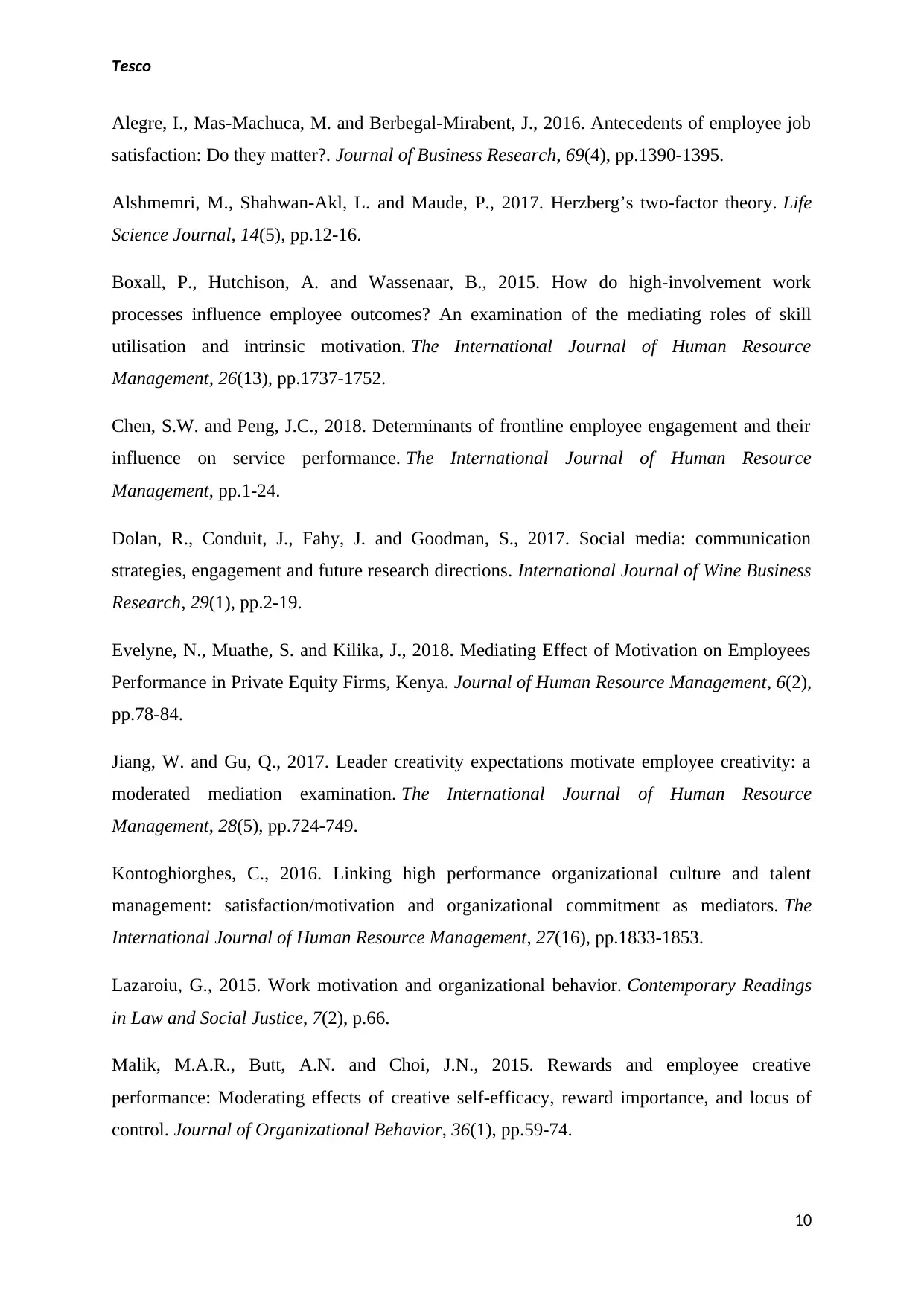
Tesco
Alegre, I., Mas-Machuca, M. and Berbegal-Mirabent, J., 2016. Antecedents of employee job
satisfaction: Do they matter?. Journal of Business Research, 69(4), pp.1390-1395.
Alshmemri, M., Shahwan-Akl, L. and Maude, P., 2017. Herzberg’s two-factor theory. Life
Science Journal, 14(5), pp.12-16.
Boxall, P., Hutchison, A. and Wassenaar, B., 2015. How do high-involvement work
processes influence employee outcomes? An examination of the mediating roles of skill
utilisation and intrinsic motivation. The International Journal of Human Resource
Management, 26(13), pp.1737-1752.
Chen, S.W. and Peng, J.C., 2018. Determinants of frontline employee engagement and their
influence on service performance. The International Journal of Human Resource
Management, pp.1-24.
Dolan, R., Conduit, J., Fahy, J. and Goodman, S., 2017. Social media: communication
strategies, engagement and future research directions. International Journal of Wine Business
Research, 29(1), pp.2-19.
Evelyne, N., Muathe, S. and Kilika, J., 2018. Mediating Effect of Motivation on Employees
Performance in Private Equity Firms, Kenya. Journal of Human Resource Management, 6(2),
pp.78-84.
Jiang, W. and Gu, Q., 2017. Leader creativity expectations motivate employee creativity: a
moderated mediation examination. The International Journal of Human Resource
Management, 28(5), pp.724-749.
Kontoghiorghes, C., 2016. Linking high performance organizational culture and talent
management: satisfaction/motivation and organizational commitment as mediators. The
International Journal of Human Resource Management, 27(16), pp.1833-1853.
Lazaroiu, G., 2015. Work motivation and organizational behavior. Contemporary Readings
in Law and Social Justice, 7(2), p.66.
Malik, M.A.R., Butt, A.N. and Choi, J.N., 2015. Rewards and employee creative
performance: Moderating effects of creative self‐efficacy, reward importance, and locus of
control. Journal of Organizational Behavior, 36(1), pp.59-74.
10
Alegre, I., Mas-Machuca, M. and Berbegal-Mirabent, J., 2016. Antecedents of employee job
satisfaction: Do they matter?. Journal of Business Research, 69(4), pp.1390-1395.
Alshmemri, M., Shahwan-Akl, L. and Maude, P., 2017. Herzberg’s two-factor theory. Life
Science Journal, 14(5), pp.12-16.
Boxall, P., Hutchison, A. and Wassenaar, B., 2015. How do high-involvement work
processes influence employee outcomes? An examination of the mediating roles of skill
utilisation and intrinsic motivation. The International Journal of Human Resource
Management, 26(13), pp.1737-1752.
Chen, S.W. and Peng, J.C., 2018. Determinants of frontline employee engagement and their
influence on service performance. The International Journal of Human Resource
Management, pp.1-24.
Dolan, R., Conduit, J., Fahy, J. and Goodman, S., 2017. Social media: communication
strategies, engagement and future research directions. International Journal of Wine Business
Research, 29(1), pp.2-19.
Evelyne, N., Muathe, S. and Kilika, J., 2018. Mediating Effect of Motivation on Employees
Performance in Private Equity Firms, Kenya. Journal of Human Resource Management, 6(2),
pp.78-84.
Jiang, W. and Gu, Q., 2017. Leader creativity expectations motivate employee creativity: a
moderated mediation examination. The International Journal of Human Resource
Management, 28(5), pp.724-749.
Kontoghiorghes, C., 2016. Linking high performance organizational culture and talent
management: satisfaction/motivation and organizational commitment as mediators. The
International Journal of Human Resource Management, 27(16), pp.1833-1853.
Lazaroiu, G., 2015. Work motivation and organizational behavior. Contemporary Readings
in Law and Social Justice, 7(2), p.66.
Malik, M.A.R., Butt, A.N. and Choi, J.N., 2015. Rewards and employee creative
performance: Moderating effects of creative self‐efficacy, reward importance, and locus of
control. Journal of Organizational Behavior, 36(1), pp.59-74.
10
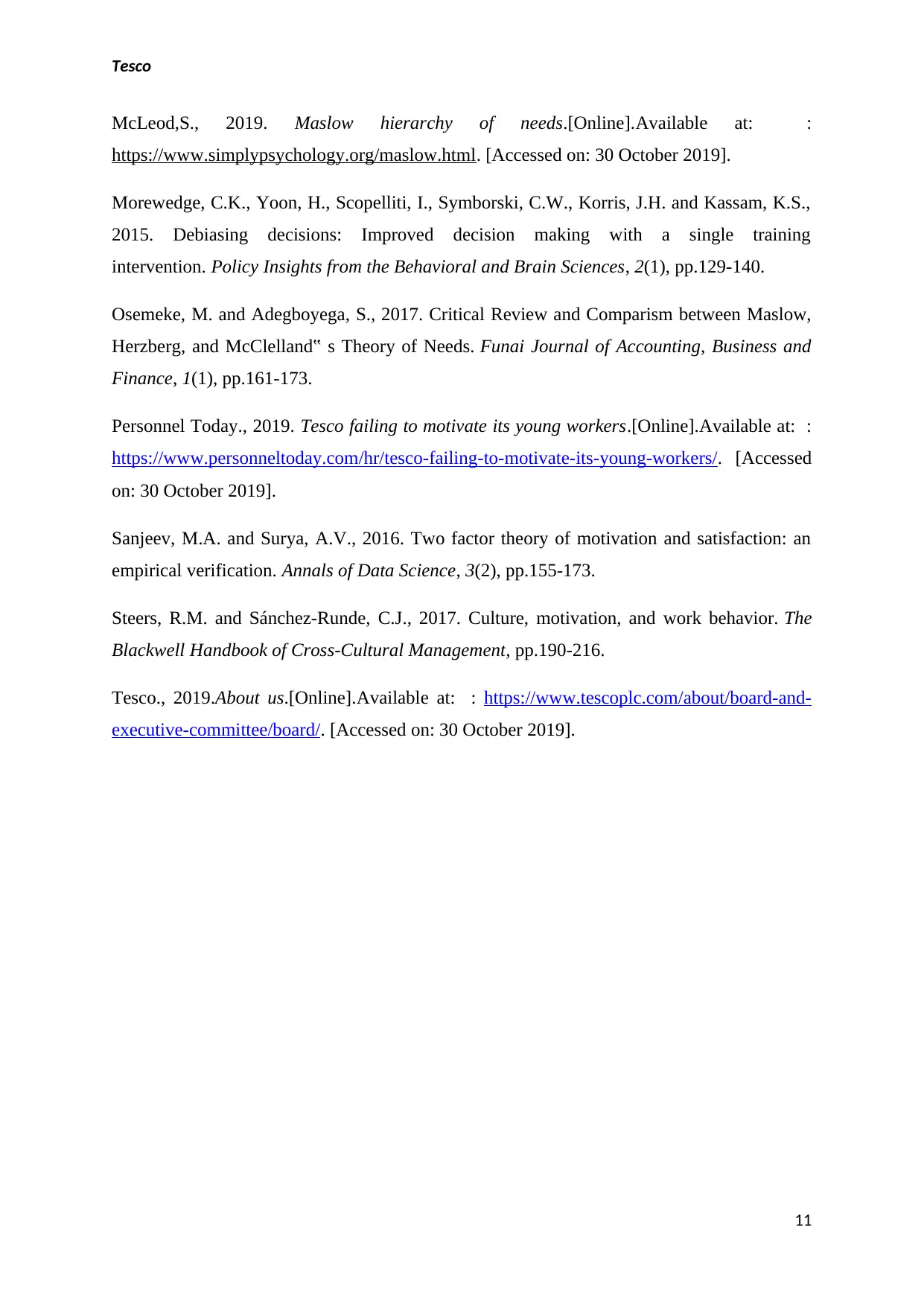
Tesco
McLeod,S., 2019. Maslow hierarchy of needs.[Online].Available at: :
https://www.simplypsychology.org/maslow.html. [Accessed on: 30 October 2019].
Morewedge, C.K., Yoon, H., Scopelliti, I., Symborski, C.W., Korris, J.H. and Kassam, K.S.,
2015. Debiasing decisions: Improved decision making with a single training
intervention. Policy Insights from the Behavioral and Brain Sciences, 2(1), pp.129-140.
Osemeke, M. and Adegboyega, S., 2017. Critical Review and Comparism between Maslow,
Herzberg, and McClelland‟ s Theory of Needs. Funai Journal of Accounting, Business and
Finance, 1(1), pp.161-173.
Personnel Today., 2019. Tesco failing to motivate its young workers.[Online].Available at: :
https://www.personneltoday.com/hr/tesco-failing-to-motivate-its-young-workers/. [Accessed
on: 30 October 2019].
Sanjeev, M.A. and Surya, A.V., 2016. Two factor theory of motivation and satisfaction: an
empirical verification. Annals of Data Science, 3(2), pp.155-173.
Steers, R.M. and Sánchez‐Runde, C.J., 2017. Culture, motivation, and work behavior. The
Blackwell Handbook of Cross‐Cultural Management, pp.190-216.
Tesco., 2019.About us.[Online].Available at: : https://www.tescoplc.com/about/board-and-
executive-committee/board/. [Accessed on: 30 October 2019].
11
McLeod,S., 2019. Maslow hierarchy of needs.[Online].Available at: :
https://www.simplypsychology.org/maslow.html. [Accessed on: 30 October 2019].
Morewedge, C.K., Yoon, H., Scopelliti, I., Symborski, C.W., Korris, J.H. and Kassam, K.S.,
2015. Debiasing decisions: Improved decision making with a single training
intervention. Policy Insights from the Behavioral and Brain Sciences, 2(1), pp.129-140.
Osemeke, M. and Adegboyega, S., 2017. Critical Review and Comparism between Maslow,
Herzberg, and McClelland‟ s Theory of Needs. Funai Journal of Accounting, Business and
Finance, 1(1), pp.161-173.
Personnel Today., 2019. Tesco failing to motivate its young workers.[Online].Available at: :
https://www.personneltoday.com/hr/tesco-failing-to-motivate-its-young-workers/. [Accessed
on: 30 October 2019].
Sanjeev, M.A. and Surya, A.V., 2016. Two factor theory of motivation and satisfaction: an
empirical verification. Annals of Data Science, 3(2), pp.155-173.
Steers, R.M. and Sánchez‐Runde, C.J., 2017. Culture, motivation, and work behavior. The
Blackwell Handbook of Cross‐Cultural Management, pp.190-216.
Tesco., 2019.About us.[Online].Available at: : https://www.tescoplc.com/about/board-and-
executive-committee/board/. [Accessed on: 30 October 2019].
11
⊘ This is a preview!⊘
Do you want full access?
Subscribe today to unlock all pages.

Trusted by 1+ million students worldwide
1 out of 12
Related Documents
Your All-in-One AI-Powered Toolkit for Academic Success.
+13062052269
info@desklib.com
Available 24*7 on WhatsApp / Email
![[object Object]](/_next/static/media/star-bottom.7253800d.svg)
Unlock your academic potential
Copyright © 2020–2025 A2Z Services. All Rights Reserved. Developed and managed by ZUCOL.




